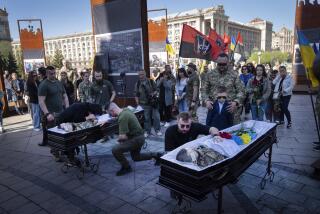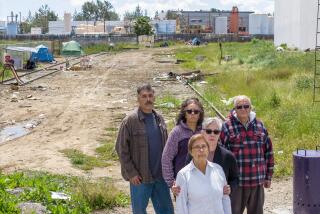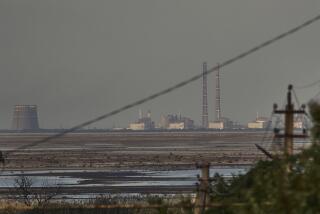Why is safety a divisive issue for Nuclear Regulatory Commission?
Reading between the lines, it’s probably fair to say that Greg Jaczko may not be someone you’d want to work for.
As chairman of the U.S. Nuclear Regulatory Commission, he’s been accused of yelling at people, browbeating subordinates and picking fights with his fellow NRC commissioners when he doesn’t get his way. That’s pretty much the totality of the bill of particulars Rep. Darrell Issa (R-Vista) put out in December in support of a concerted, albeit unsuccessful, campaign to drive Jaczko from his job.
(Jaczko has acknowledged that there are strong disagreements within the agency, but vehemently denies being especially tough on women, another charge made by Issa.)
What the report on Jaczko issued by Issa’s committee on oversight and government reform didn’t delve into too deeply, however, were the policy issues underlying the personal friction. That’s too bad, because the disagreements concerned Jaczko’s efforts to tighten safety and security regulations for the nation’s 104 nuclear power reactors, in the face of the other commissioners’ efforts to slow him down.
Given what the agency’s critics say is its customary laxness in matters of safety and security, you’d think that would be the central concern of a committee devoted to government oversight. Not in this case.
Issa’s relentless focus on trivialities now threatens to bite him where it hurts. Safety issues are at the heart of the unfolding fiasco at Southern California Edison’s San Onofre nuclear plant, which is in Issa’s district. San Onofre was completely shut down starting in February, after engineers discovered unexpectedly extensive wear in brand new generators installed at a cost of nearly $700 million.
By then, at least one leak had released a small amount of radioactivity into the atmosphere. It’s a good bet that the plant will stay offline through the peak electrical demand months of summer, posing the prospect of blackouts and higher costs for customers across Southern California.
The entire affair points to the possibility that the NRC allowed Edison to make design changes in the equipment without adequate regulatory input, which is the level of performance NRC critics have warned about for years, and which got short shrift from Issa.
The congressman wisely has taken a hands-off stance on the NRC’s current investigation of San Onofre. “The dysfunction at the NRC that the committee has looked at is very much a separate question from what’s going on with the situation at San Onofre,” Issa’s spokesman, Frederick Hill, told me. Perhaps, but many independent NRC watchdogs think San Onofre raises more important questions about the NRC than those on which Issa did sound off.
“There are a lot of other things at the NRC worth examining by Congress,” says Edwin Lyman, a nuclear expert at the Union of Concerned Scientists. Other longtime critics of the agency suggest that Issa’s focus on personal spats was misplaced in Washington, where sharp elbows are part of the standard armory for turf battles. It’s bizarre to see Issa trying to pillory Jaczko for being highhanded — he’s not above being highhanded himself when it serves his purpose. (Ask the general counsel of the National Labor Relations Board, the target of an earlier Issa campaign.)
It’s important to be mindful that all five NRC members are pro-nuclear to varying degrees. All are scientists or engineers.
Three are Democrats. Jaczko, who has served on the commission since 2005 and was appointed chairman in 2009, holds a physics doctorate from the University of Wisconsin and served as an aide to Rep. Ed Markey (D-Mass.) and Senate Majority Leader Harry Reid (D-Nev.) before joining the agency. George E. Apostolakis is a former MIT professor and William D. Magwood a physicist and former manager at the utility industry’s Edison Electric Institute.
Two are Republicans: Kristine L. Svinicki was a nuclear engineer at the Department of Energy, and William C. Ostendorff is an engineer and former submarine commander.
One might expect, at worst, that the commission would split along partisan lines. But NRC watchers say their votes more typically reflect their attitudes toward regulating the nuclear power industry. Jaczko often finds himself on the losing side in 4-1 votes, with the majority favoring less stringent safety and security initiatives.
“Greg’s not anti-nuclear,” says Christopher Paine, director of the nuclear program at the Natural Resources Defense Council, “but he’s pro-nuclear in a smart and considered way. He’s the first NRC chairman who’s been serious about nuclear safety in quite some time.”
The most important issue driving a wedge between Jaczko and the four other commissioners has been how to shore up nuclear safety in the wake of the March 2011 earthquake and tsunami that destroyed Japan’s coastal Fukushima Daiichi nuclear plant.
Extensive radioactive contamination was released into the environment while crews struggled in vain to contain the disaster. Jaczko convened a high-level task force to propose safety upgrades at U.S. plants in light of Fukushima — not least at California’s San Onofre and Diablo Canyon plants, which similarly are situated in coastal earthquake zones with limited options for large-scale emergency evacuations.
After the task force issued its report in July, Jaczko moved to make its 12 recommendations public and implement them promptly.
These included strengthening containment buildings and spent fuel storage, which proved to be weak spots at Fukushima, and safeguarding against total plant blackouts, which led to much of the damage at the Japanese plant. But the other commissioners thwarted this effort, moving instead to tie up the report and its recommendations in bureaucratic procedure — a “regulatory meltdown,” as Rep. Markey described it in a report in December.
“Jaczko wanted to use Fukushima as a galvanizing event to reform the NRC,” says the NRDC’s Paine. He’s been unsuccessful. As recently as Feb. 9, Jaczko’s attempt to write mandates for post-Fukushima safety upgrades into a new license for a nuclear plant in Georgia was voted down, 4 to 1, provoking him to complain that the commission was acting “as if Fukushima had never happened.”
Agency critics say its coziness with the utility industry may also be implicated at San Onofre, that full-featured facility on Interstate 5 a few miles south of San Clemente.
When Edison decided several years ago to replace the plant’s aging steam generators, it described the new equipment as essentially identical to the old and said the work would involve only “minimal … modifications” to the plant. That’s according to a technical paper issued under the imprimatur of Edison and the generator manufacturer, Mitsubishi Heavy Industries. Edison maintained, therefore, that the work would not require extensive and costly prior approval, even a re-licensing, by the NRC. The agency agreed.
But the changes may have been not so minor. The technical paper acknowledges that the four modernized generators, which each comprised more than 9,700 alloy metal tubes with walls the thickness of a dime, presented “unique design and fabrication challenges.”
Among other points, the new generators encompassed 4% more tubes than the old, which may have produced novel stresses on the components. These challenges were supposedly addressed at the manufacturing stage. But although the critical goal was to minimize the potential for tube wear because of vibration, the technical paper says, it was not known whether the product “would eventually perform as specified.”
It hasn’t: Engineers are focusing on vibration as the cause of premature wear in hundreds of tubes, increasing the potential for ruptures that could release radioactivity into the environment.
The larger question is whether NRC staff waved through a design change they should have scrutinized attentively. The agency says it’s examining whether Edison told it all it needed to know about the redesign, and whether its own staff should have pushed back against the utility’s contention that the changes were no big deal.
On the surface the agency seems to have dropped the ball. “A major regulatory function was unacceptably cast aside,” says Damon Moglen, climate and energy director at Friends of the Earth, which has produced useful analyses of the redesign.
That happened under the supposedly more collegial pre-Jaczko regime. “The most Greg is guilty of is raising his voice and getting passionate,” says NRDC’s Paine. “Apparently you can’t get passionate about issues on the NRC, you have to be ‘reasoned.’ Everybody’s been reasoned and calm over there, but they’ve basically been doing industry’s bidding. So they tried to get rid of Jaczko.”
Michael Hiltzik’s column appears Sundays and Wednesdays. Reach him at mhiltzik@latimes.com, read past columns at latimes.com/hiltzik, check out facebook.com/hiltzik and follow @latimeshiltzik on Twitter.







